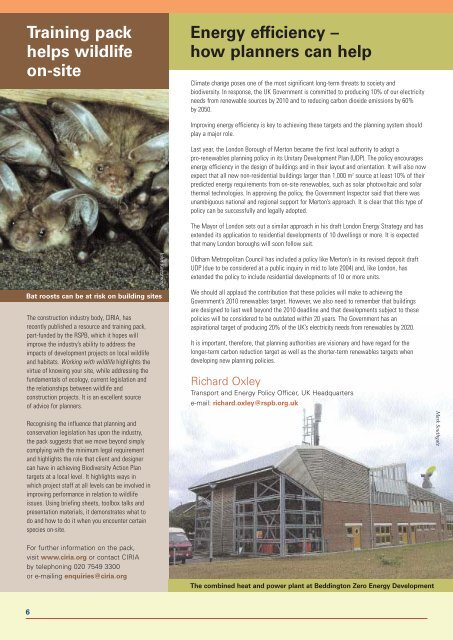Conservation Planner 20 - RSPB
Conservation Planner 20 - RSPB
Conservation Planner 20 - RSPB
Create successful ePaper yourself
Turn your PDF publications into a flip-book with our unique Google optimized e-Paper software.
Training pack<br />
helps wildlife<br />
on-site<br />
Energy efficiency –<br />
how planners can help<br />
Climate change poses one of the most significant long-term threats to society and<br />
biodiversity. In response, the UK Government is committed to producing 10% of our electricity<br />
needs from renewable sources by <strong>20</strong>10 and to reducing carbon dioxide emissions by 60%<br />
by <strong>20</strong>50.<br />
Improving energy efficiency is key to achieving these targets and the planning system should<br />
play a major role.<br />
Last year, the London Borough of Merton became the first local authority to adopt a<br />
pro-renewables planning policy in its Unitary Development Plan (UDP). The policy encourages<br />
energy efficiency in the design of buildings and in their layout and orientation. It will also now<br />
expect that all new non-residential buildings larger than 1,000 m 2 source at least 10% of their<br />
predicted energy requirements from on-site renewables, such as solar photovoltaic and solar<br />
thermal technologies. In approving the policy, the Government Inspector said that there was<br />
unambiguous national and regional support for Merton’s approach. It is clear that this type of<br />
policy can be successfully and legally adopted.<br />
The Mayor of London sets out a similar approach in his draft London Energy Strategy and has<br />
extended its application to residential developments of 10 dwellings or more. It is expected<br />
that many London boroughs will soon follow suit.<br />
Bat roosts can be at risk on building sites<br />
The construction industry body, CIRIA, has<br />
recently published a resource and training pack,<br />
part-funded by the <strong>RSPB</strong>, which it hopes will<br />
improve the industry’s ability to address the<br />
impacts of development projects on local wildlife<br />
and habitats. Working with wildlife highlights the<br />
virtue of knowing your site, while addressing the<br />
fundamentals of ecology, current legislation and<br />
the relationships between wildlife and<br />
construction projects. It is an excellent source<br />
of advice for planners.<br />
John Kaczanow<br />
Oldham Metropolitan Council has included a policy like Merton’s in its revised deposit draft<br />
UDP (due to be considered at a public inquiry in mid to late <strong>20</strong>04) and, like London, has<br />
extended the policy to include residential developments of 10 or more units.<br />
We should all applaud the contribution that these policies will make to achieving the<br />
Government’s <strong>20</strong>10 renewables target. However, we also need to remember that buildings<br />
are designed to last well beyond the <strong>20</strong>10 deadline and that developments subject to these<br />
policies will be considered to be outdated within <strong>20</strong> years. The Government has an<br />
aspirational target of producing <strong>20</strong>% of the UK’s electricity needs from renewables by <strong>20</strong><strong>20</strong>.<br />
It is important, therefore, that planning authorities are visionary and have regard for the<br />
longer-term carbon reduction target as well as the shorter-term renewables targets when<br />
developing new planning policies.<br />
Richard Oxley<br />
Transport and Energy Policy Officer, UK Headquarters<br />
e-mail: richard.oxley@rspb.org.uk<br />
Recognising the influence that planning and<br />
conservation legislation has upon the industry,<br />
the pack suggests that we move beyond simply<br />
complying with the minimum legal requirement<br />
and highlights the role that client and designer<br />
can have in achieving Biodiversity Action Plan<br />
targets at a local level. It highlights ways in<br />
which project staff at all levels can be involved in<br />
improving performance in relation to wildlife<br />
issues. Using briefing sheets, toolbox talks and<br />
presentation materials, it demonstrates what to<br />
do and how to do it when you encounter certain<br />
species on-site.<br />
Mark Southgate<br />
For further information on the pack,<br />
visit www.ciria.org or contact CIRIA<br />
by telephoning 0<strong>20</strong> 7549 3300<br />
or e-mailing enquiries@ciria.org<br />
The combined heat and power plant at Beddington Zero Energy Development<br />
6

















